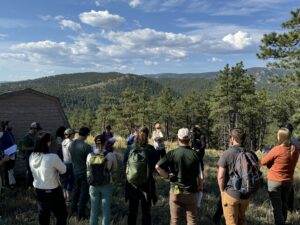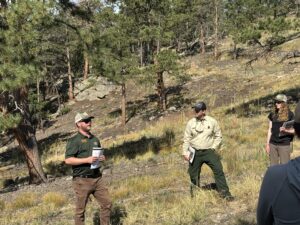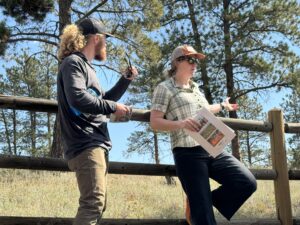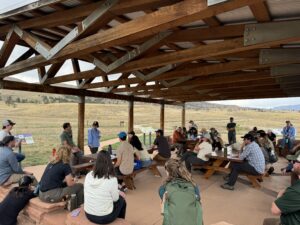 We recently spent a beautiful day out in the Northern Front Range, surrounded by a vibrant community of partners, scientists, and land managers working together to build more resilient landscapes. This was the first of two field trips leading up to the 2024 Front Range Forest and Fire Symposium, and it brought together leading experts in forest management, wildfire mitigation, and ecological monitoring to share key insights from ongoing projects.
We recently spent a beautiful day out in the Northern Front Range, surrounded by a vibrant community of partners, scientists, and land managers working together to build more resilient landscapes. This was the first of two field trips leading up to the 2024 Front Range Forest and Fire Symposium, and it brought together leading experts in forest management, wildfire mitigation, and ecological monitoring to share key insights from ongoing projects.
The field trip focused on a few critical themes:
- How the Cameron Peak Fire increased the urgency and need for landscape-scale collaborative planning and prioritization.
- What we have learned about treatment effectiveness of mechanical thinning at Pole Hill from monitoring.
- How we can learn from inevitable wildfires like the recent Alexander Mountain Fire to help us better address all three goals of the National Cohesive Wildland Fire Management Strategy.
- Past wildfire and treatment interactions, revegetation, and long-term post-fire planning.
Collaborative Planning in a Post-Cameron Peak Fire Landscape
 The devastating 2020 Cameron Peak Fire has amplified the need for coordinated, large-scale forest management across the Northern Front Range. Peaks to People has been at the heart of these efforts, working alongside the Northern Colorado Fireshed Collaborative and other partners to implement science-backed, collaborative strategies that improve forest health while mitigating the risk of catastrophic fires.
The devastating 2020 Cameron Peak Fire has amplified the need for coordinated, large-scale forest management across the Northern Front Range. Peaks to People has been at the heart of these efforts, working alongside the Northern Colorado Fireshed Collaborative and other partners to implement science-backed, collaborative strategies that improve forest health while mitigating the risk of catastrophic fires.
One of the frameworks discussed during the field trip was the Potential Operational Delineations (PODs) tool, which is helping prioritize areas for treatment. Daniel Godwin, Wildfire Crisis Strategy Program Manager for the Arapaho and Roosevelt NF & Pawnee NG, provided an overview of this planning framework, underscoring how it is being used to make informed decisions across landscapes.
Peaks to People played a valuable role in developing and launching the PODs dashboard, now widely used by land managers across Northern Colorado. Max Erickson, Supervisory Forester at the Colorado State Forest Service Fort Collins Field Office, stated that the tool is improving their ability to plan and prioritize critical treatment areas in fire-prone landscapes. The dashboard equips fire managers and stakeholders with the data needed to make timely, informed decisions to reduce wildfire risk.
Monitoring and Learning from Fire Events
 Monitoring and adaptive management are core principles that drive the long-term effectiveness of forest treatments. At Pole Hill, we’ve been learning a great deal about the outcomes of mechanical thinning, a method that helps reduce wildfire risk by clearing excess vegetation. Dylan Alsbach and Gretchen Reuning from the Larimer Conservation District provided an insightful synopsis of the restortaion work their agency has been doing in this community since 2017, projects partially funded by Peaks to People since 2020. This work has shown promising results, with enhanced landscape connectivity and improved resilience in the face of fire threats.
Monitoring and adaptive management are core principles that drive the long-term effectiveness of forest treatments. At Pole Hill, we’ve been learning a great deal about the outcomes of mechanical thinning, a method that helps reduce wildfire risk by clearing excess vegetation. Dylan Alsbach and Gretchen Reuning from the Larimer Conservation District provided an insightful synopsis of the restortaion work their agency has been doing in this community since 2017, projects partially funded by Peaks to People since 2020. This work has shown promising results, with enhanced landscape connectivity and improved resilience in the face of fire threats.
The effectiveness of these treatments is being closely monitored, as explained by Kat Morici from the Colorado Forest Restoration Institute (CFRI). Peaks to People provided funding to CFRI to monitor the effectiveness of mechanical thinning in this landscape to help land managers better understand which treatments work best and under what conditions. This data is essential as we continue to refine our approaches to forest management and wildfire risk reduction.
Responding to Wildfire: Learning from the Alexander Mountain Fire and Beyond
During a scenic lunch alongside the Big Thompson River, Camille Stevens-Rumann from the Colorado Forest Restoration Institute and Daniel Godwin led an insightful discussion on lessons learned from Northern Colorado’s recent wildfires. The Alexander Mountain Fire, which occurred in August 2024, is a fresh reminder of how quickly conditions can change and the need for robust post-fire recovery plans.
Peaks to People, in collaboration with the Big Thompson Watershed Health Partnership (BTWHP) and other local organizations, is already leaning on its ongoing Wildfire Ready Action Plan (WRAP) to guide recovery planning for the Alexander Mountain Fire. Although we are only mid-way through the WRAP process, the completed hazard analyses have been instrumental in shaping initial recovery strategies, demonstrating the importance of proactive planning and collaboration.
A Vision for the Future: Long-Term Post-Fire Recovery
Our final stop brought us face-to-face with the complexities of forest recovery in a changing climate. Marin Chambers from the Colorado Forest Restoration Institute and Mike Battaglia from the Rocky Mountain Research Station shared their expertise on natural forest recovery, the interactions between past wildfires like the Bobcat Ridge and Cameron Peak Fires, and the pressing need for climate change adaptation. Their insights on reforestation, mitigation efforts, and assisted migration underscored the long-term nature of this work.
Peaks to People: A Catalyst for Collaboration
This field trip was a powerful reminder of the value of collaboration, science, and adaptive management in our forest management efforts. Peaks to People is proud to be an integral part of these ongoing conversations, providing funding, tools, and support for projects that are making a real difference on the ground.
Throughout the day, the impact of Peaks to People’s funding, leadership, and collaborative spirit was evident. From supporting critical tools like the PODs Dashboard to funding on-the-ground treatments and monitoring, Peaks to People continues to be a driving force in protecting Northern Colorado’s forests and watersheds. Our role in the development of the WRAP for the Big Thompson Watershed, alongside key partners, ensures that we remain proactive in addressing wildfire risk while fostering healthier, more resilient ecosystems.
This field trip was not only an opportunity to learn from past and current projects but also a reminder of the shared responsibility we all have in preparing for the future. Peaks to People is excited to be part of this ongoing journey, working hand-in-hand with local partners to build a safer, more sustainable landscape for generations to come.
Acknowledgments
A special thank you to all the event organizers and speakers who made this day a success, including the Colorado Forest Restoration Institute, Colorado State Forest Service, Natural Resources Conservation Service, Larimer Conservation District, US Forest Service Rocky Mountain Research Station, US Forest Service Arapaho and Roosevelt National Forests and Pawnee National Grassland, US Forest Service Pike-San Isabel National Forest & Cimarron and Comanche National Grasslands.
Stay tuned for more insights as we continue to explore innovative approaches to wildfire resilience and ecological restoration.

